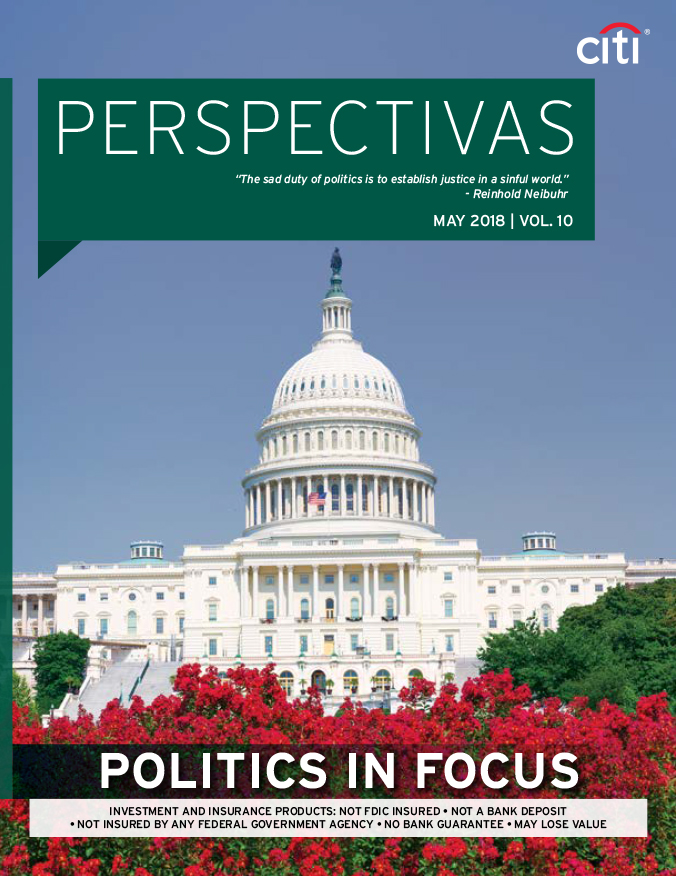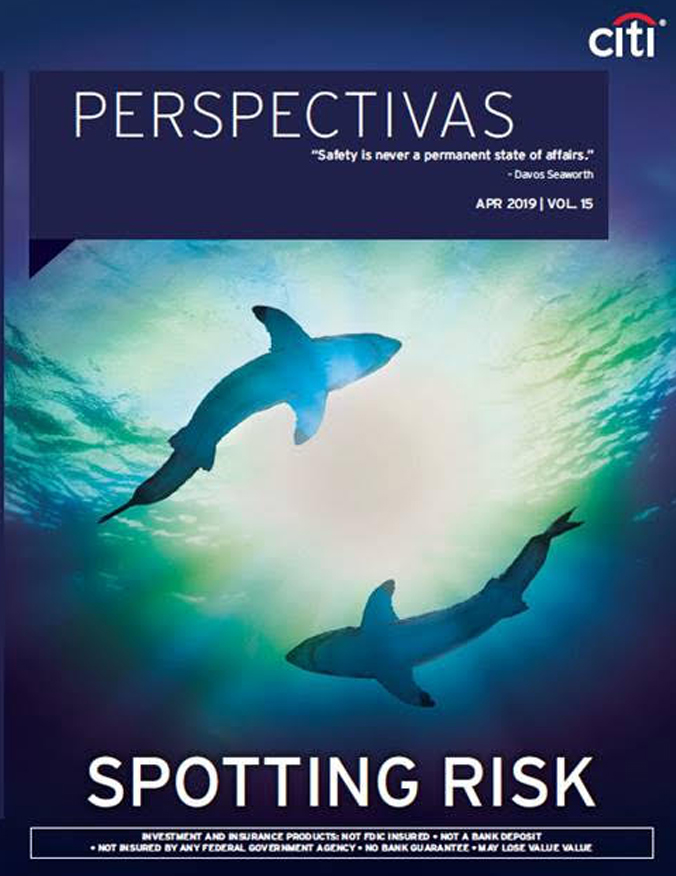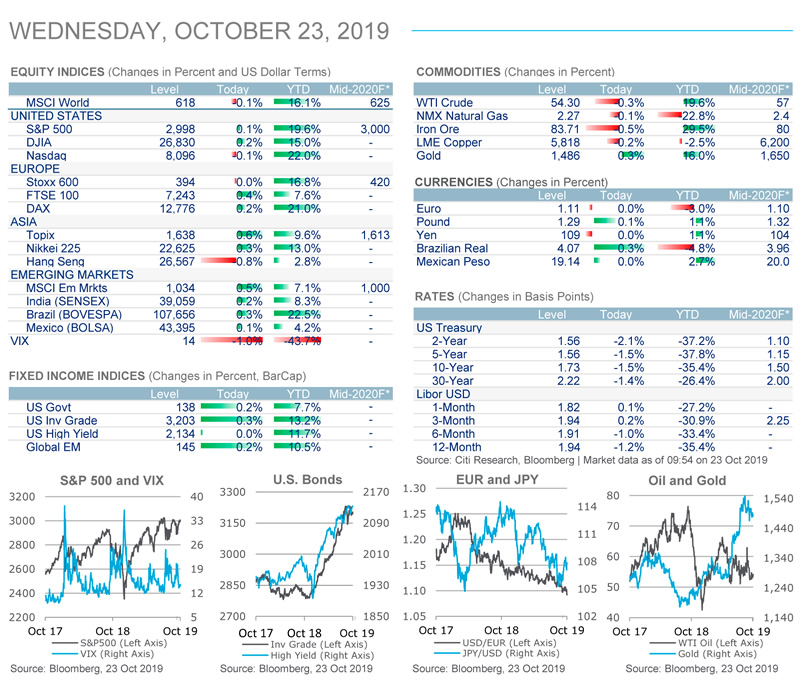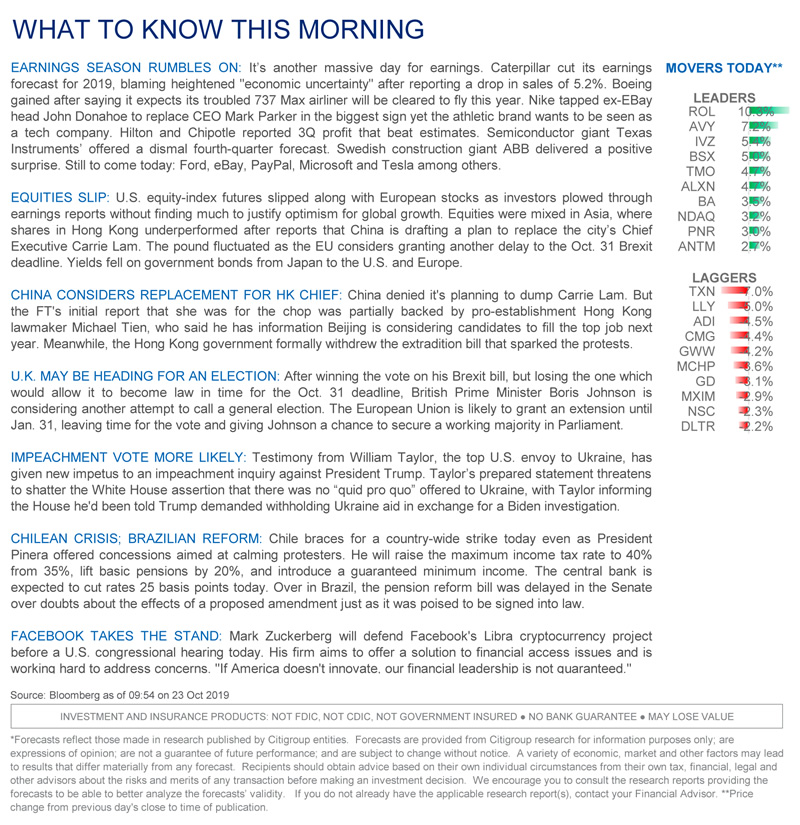- Una nota a nuestros clientes actuales sobre avisos de inversión y COVID-19 Haga clic aquí para ver
Hace poco le enviamos avisos sobre actualizaciones a su acuerdo del cliente. Desafortunadamente, el Servicio Postal de EE. UU. anunció interrupciones de servicio debido a la pandemia de COVID-19 para determinada correspondencia proveniente de Estados Unidos, por lo que es posible que demore en recibir estos avisos. Le recomendamos revisar en Internet las actualizaciones, las cuales incluyen nuevos detalles acerca de la entrega electrónica de documentos de divulgación, además de otra información importante sobre su(s) cuenta(s).
- Si abrió una cuenta de Citi International Financial Services, LLC antes del 15 de abril de 2020, haga clic aquí para leer el Acuerdo del cliente de CIFS enmendado que le enviamos por correo postal.
- Si abrió una cuenta de Citi Personal Investments International antes del 31 de marzo de 2020, haga clic aquí para leer el aviso importante que le enviamos en su estado de cuenta de marzo.
- Si abrió su(s) cuenta(s) después de estas fechas, consulte el acuerdo del cliente que recibió cuando la(s) abrió.

Inversión
Soluciones holísticas de administración patrimonial creadas para satisfacer sus necesidades financieras.
Descubra el poder de su patrimonio
Estrategia personalizada
No hay una única solución para todo.

Por qué invertir con nosotros
En International Personal Bank U.S., hemos diseñado nuestros servicios de inversión en función de sus necesidades, permitiéndole trabajar estrechamente con uno de nuestros ejecutivos financieros en lugar de administrar sus inversiones por su cuenta.

Soluciones personalizadas
Ofrecemos una amplia gama de productos y servicios bancarios y de inversión para ayudarlo a crear una solución personalizada para usted. International Personal Bank U.S. le permite traducir lo más importante en una estrategia financiera detallada.

Guía de inversión profesional
Su ejecutivo financiero personal forma parte de un equipo con acceso a otros especialistas, incluyendo mercados de capitales, inversiones alternativas e inversiones internacionales, entre otros.
Con el respaldado de la solidez y los recursos de Citi, International Personal Bank U.S. empodera a los clientes de todo el mundo a trabajar para lograr sus objetivos financieros para ayudarles a disfrutar de los beneficios de la administración patrimonial basada en los Estados Unidos.
Sea usted un cliente que invierte por primera vez o un cliente actual, nuestro distintivo proceso de inversión está diseñado para ayudarle a desarrollar e implementar su estrategia financiera.
| Paso 1 Determinar o validar su perfil de inversión | Paso 2 Revisar su distribución de activos | Paso 3 Analizar su cartera usando las perspectivas de inversión de Citi | Paso 4 Desarrollar o rebalancear su cartera personalizada | Paso 5 Revisar su cartera a su solicitud |
|---|---|---|---|---|
| Identificar sus necesidades y su perfil de inversión | Revisar las estrategias de distribución de activos para alinearlas con sus objetivos | Aplicar las mejores ideas de Citi para adaptar su estrategia de inversión | Seleccionar productos de inversión basados en su perfil y en nuestro conocimiento del mercado para crear su cartera | Revisar su cartera a su solicitud, ajustándose a las condiciones cambiantes |
| ¿Cuáles son sus objetivos a largo y corto plazo? ¿Cuáles son sus necesidades de liquidez? ¿Cuál es su nivel de tolerancia al riesgo? ¿Cuál es su experiencia en inversiones y cuánto conoce los productos? Nota: Esta inversión no se limita a los componentes indicados arriba | Ya sea que desee una estrategia conservadora de preservación del capital, una estrategia agresiva de crecimiento del capital o una estrategia moderada, contamos con las herramientas para ayudarle a implementar esos objetivos | Benefíciese de los recursos de capital intelectual de Citi, que le brindan información, comentarios del mercado y liderazgo de pensamiento para inversiones | El proceso de selección de productos y distribución de activos implica diversificar su cartera con distintas clases de activos, sectores y regiones geográficas, entre otros factores | Estamos disponibles para revisar su cartera para alinear su estrategia de cartera con las condiciones cambiantes |
Determinar o validar su perfil de inversión
¿Cuáles son sus objetivos a largo y corto plazo?
¿Cuáles son sus necesidades de liquidez?
¿Cuál es su nivel de tolerancia al riesgo?
¿Cuál es su experiencia en inversiones y cuánto conoce los productos?
Nota: Esta inversión no se limita a los componentes indicados arriba
Revisar su distribución de activos
Analizar su cartera usando las perspectivas de inversión de Citi
Desarrollar o rebalancear su cartera personalizada
Revisar su cartera a su solicitud
Proceso de inversión adaptable de Citi
El proceso de inversión adaptable de Citi combina planificación a largo plazo con oportunidades y opiniones sobre el mercado a corto plazo alineadas con sus objetivos.
Fundamentado en principios establecidos a través de investigación académica, nuestro proceso adaptable hace uso de:
Un conjunto de oportunidades globales compuesto por diferentes tipos de inversión en todas las geografías
Estudios de historia de marcas financieras durante muchas décadas
Valoraciones actuales y estimaciones de rendimientos futuros
Medidas de los riesgos más relevantes para los inversores
El proceso de inversión adaptable asigna distribuciones estratégicas en función de:
Perfil de inversión individual
Diferentes grados de tolerancia al riesgo
Apetito de riesgo a la baja
Los integrantes de nuestro equipo dedicado trabajan juntos para su éxito
Mediante conversaciones directas con usted, un equipo multilingüe experimentado le ayuda a identificar sus objetivos financieros y lo apoya en la selección de una combinación personalizada de productos y servicios diseñados para ayudarle a trabajar para lograr sus objetivos y necesidades financieras particulares.
1 Disponible para clientes Citigold® Private Client International.
2 Análisis propio proporcionado por Citi Private Bank y otras entidades de Citi.
Manteniendo en perspectiva las condiciones cambiantes del mercado, las circunstancias financieras y sus metas de largo plazo, nuestro equipo dedicado de ejecutivos financieros identificará sus objetivos únicos para desarrollar su estrategia de inversión.
Cómo entender su nivel de tolerancia al riesgo de inversión
- Crear una estrategia financiera personalizada requiere la consideración de los riesgos financieros.
- Existe una ventaja comparativa entre el riesgo asociado con una inversión y su rendimiento esperado con el paso del tiempo.
- La tolerancia al riesgo se define como la sensibilidad de un cliente a la variabilidad de los rendimientos en su cuenta durante un plazo de un año, la disposición a absorber las pérdidas potenciales y la aceptación de poder liquidar las inversiones en forma oportuna o a un precio determinado.
- Cada inversor tiene una actitud distinta frente al riesgo y comprender esto es fundamental para encontrar inversiones que puedan ser correctas para usted.
- En función de una entrevista con su Ejecutivo Financiero, se establecerá su perfil de inversión en el momento de la apertura de cuenta, tomando en consideración su nivel de tolerancia al riesgo, las necesidades de liquidez, los objetivos de inversión, el plazo de inversión, los conocimientos y experiencia, y otros factores.
Tipo de niveles de tolerancia al riesgo
CONSERVADOR | ||
|---|---|---|
CONSERVADOR | Los inversores que esperan no experimentar más que pequeñas pérdidas de cartera en un período continuo de un año y generalmente solo están dispuestos a comprar inversiones que tienen un precio frecuente y tienen una alta certeza de poder vender rápidamente (menos de una semana), aunque el inversor puede, en ocasiones, comprar inversiones individuales que conlleven un mayor riesgo. | |
MODERADO | ||
MODERADO | Los inversores que esperan experimentar pérdidas de cartera no más que moderadas durante un período continuo de un año al intentar mejorar el rendimiento a más largo plazo y generalmente están dispuestos a comprar inversiones que tienen un precio frecuente y tienen una alta certeza de poder vender rápidamente (menos de una semana) en mercados estables, aunque el inversor a veces puede comprar inversiones individuales que conllevan un mayor riesgo y son menos líquidas. | |
AGRESIVO | ||
AGRESIVO | Inversores que están preparados para aceptar mayores pérdidas de cartera durante un período continuo de un año mientras intentan mejorar el rendimiento a más largo plazo y están dispuestos a comprar inversiones o celebrar contratos que pueden ser difíciles de vender o cerrar en un corto período de tiempo o que tienen una realización incierta valor en cualquier momento dado. | |
MUY AGRESIVO | ||
MUY AGRESIVO | Los inversores que están preparados para poner en riesgo toda su cartera durante un período de un año, y que incluso se les puede exigir que proporcionen capital adicional para compensar las pérdidas de la cartera más allá del monto inicialmente invertido, generalmente están dispuestos a comprar inversiones o celebrar contratos que pueden ser difícil de vender o cerrar durante un período prolongado o tener un valor de realización incierto en un momento dado. | |
¿Cómo transformamos su perfil de inversión, incluidos los objetivos de inversión y la tolerancia al riesgo en su estrategia financiera?
En International Personal Bank U.S., le ofrecemos mucho más que soluciones bancarias. Ofrecemos acceso a las percepciones y al liderazgo de Citi para ayudarlo a tomar las decisiones más informadas todos los días.
Opiniones sobre inversiones
Citi Perspectivas es una publicación bimensual destinada a brindarle la perspectiva económica de Citi, cubriendo los problemas más apremiantes que afectan su cartera. Esta publicación presenta:
- Datos analíticos: nuestras mejores ideas sobre los mercados financieros mundiales con foco en los mercados locales. Vea una muestra de Citi Perspectivas aquí
- Comentarios exclusivos: contiene comentarios del equipo de inversiones de IPB U.S., siguiendo los lineamientos de los principales analistas de investigación y estrategas de Citi
- Traducciones multilingües: disponibles en múltiples idiomas: inglés, español, portugués, ruso y chino



Actualización diaria del mercado
The Market Today le brinda información diaria de los mercados financieros, desde niveles de los índices y pronósticos de Citi hasta las noticias que mueven a los mercados todos los días.
Datos sobre los mercados
Acciones, renta fija, monedas y más

Que hay que saber esta mañana
Un resumen ejecutivo de las condiciones de mercado

Citi Global Perspectives and Solutions
Citi Global Perspectives & Solutions (Citi GPS) está diseñado para ayudarle a atravesar los desafíos más exigentes de la economía mundial, identificar temas y tendencias futuras y prosperar en un mundo interconectado y en constante cambio.
Citi GPS accede los mejores elementos de la conversación global de Citi y recopila perspectivas de los analistas de investigación y una amplia gama de profesionales sénior de la firma.

Tecnología en acción
La era digital producirá más conmoción que las revoluciones tecnológicas anteriores lo que generará alteraciones en la forma en que vivimos y trabajamos.
Obtenga Más Información sobre Tecnología en Acción
Innovaciones disruptivas VI
Los conceptos de vanguardia en los sectores nos ayudan a identificar productos nuevos que podrían desestabilizar el mercado.
Obtenga Más Información sobre innovaciones disruptivas
Migración y la economía
Una perspectiva detallada y equilibrada sobre el efecto de la inmigración en las economías avanzadas.
Obtenga Más Información sobre migración y la economíaACCIONES
- ¿Está buscando crecimiento del capital?
- ¿Se siente cómodo con las fluctuaciones diarias en el valor?
RENTA FIJA
- ¿Está interesado en ingresos por intereses periódicos?
- ¿Está buscando estrategias de preservación de capital?
OPCIONES
- ¿Quiere generar ingresos adicionales de las inversiones en acciones?
- ¿Está buscando limitar el potencial de pérdida durante las crisis de los mercados de valores?
FONDOS MUTUOS
- ¿Prefiere trabajar con administradores de fondos profesionales?
- ¿Desea acceder a una canasta más amplia de valores que podría variar según el sector, la región, la clase de activos y el producto?
PRODUCTOS ESTRUCTURADOS
- ¿Está buscando un producto personalizado que viene con beneficios derivados?
- ¿Necesita que su capital esté protegido?
CUENTAS CON ASESORAMIENTO
- ¿Requiere múltiples niveles de servicio y asesoramiento?
- ¿Está buscando control continuo?
- ¿Está dispuesto a pagar un costo anual por administración profesional?
INVERSIONES ALTERNATIVAS1
- ¿Quiere complementar su cartera con productos alternativos además de sus acciones y bonos tradicionales?
- ¿Es su plazo de inversión lo suficientemente largo para estar en inversiones ilíquidas?
La diversificación y distribución de activos no garantiza ganancias ni protege contra pérdidas.
1Las inversiones alternativas incluyen fondos de cobertura, entre otros.
El rendimiento pasado no garantiza los resultados futuros. Los inversionistas deben
analizar y considerar detenidamente los posibles riesgos antes de invertir.
Todas las
inversiones conllevan un riesgo significativo, incluida la pérdida del capital. Para ver
los riesgos de inversión detallados, haga clic aquí.
Nuestro proceso de selección de productos
Sigue un enfoque riguroso para seleccionar productos personalizados para usted
Información importante que debe saber sobre nuestro negocio y nuestra relación con usted
Se nos requiere entregar dos documentos de divulgación importantes acerca de nuestro negocio y nuestra relación con usted:
- El Formulario de Resumen de relación con el cliente (Formulario CRS) es un breve resumen de los servicios de corretaje y asesoramiento que ofrecemos.
- La Declaración sobre la divulgación de la Norma del mayor beneficio (Regulation Best Interest Disclosure Statement) es una descripción más detallada de los servicios de corretaje que ofrecemos y de las obligaciones que tenemos conforme a la Norma del mayor beneficio (Reg BI) al momento de hacerle recomendaciones como sus corredores de bolsa.
Por favor, revise estos dos documentos importantes en línea a través de los enlaces que aparecen a continuación. Si prefiere copias impresas, comuníquese con su ejecutivo financiero o llámenos a los números de teléfono indicados.
Citi Personal Investments International:
Formulario CRS Citi Personal Investments International
Declaración sobre la divulgación de la Norma del mayor beneficio (Regulation Best Interest Disclosure Statement) Citi Personal Investments International
Teléfono: 1-877-836-9141 (sin cargo desde EE. UU.) o 1-210-677-3793 (Número TTY: 1-800-788-6775)
¿Tiene Preguntas? Contáctenos
Los productos y servicios de inversión son ofrecidos por Citi Personal Investments International ("CPII"), un negocio de Citigroup Inc., que ofrece títulos a través de Citigroup Global Markets Inc. ("CGMI"), miembro de FINRA y SIPC, asesor de inversiones y corredor/intermediario registrado ante la Comisión de Bolsa y Valores (SEC). Las cuentas de inversión son administradas por Pershing LLC., ("Pershing"), miembro de FINRA, NYSE y SIPC. Los productos y servicios de seguros se ofrecen a través de Citigroup Life Agency LLC ("CLA"). En California, CLA opera bajo el nombre Citigroup Life Insurance Agency, LLC (número de licencia 0G56746). Citibank N.A., CGMI y CLA son filiales bajo el control común de Citigroup Inc.
Por favor, haga clic aquí para acceder a divulgaciones importantes.
Información importante
Está dejando el website de International Personal Bank U.S.
Información importante
Está dejando el website de International Personal Bank U.S.
Notificación importante
Por favor, tenga en cuenta que es posible que las comunicaciones futuras del banco, ya sean verbales o escritas, sean únicamente en inglés. Estas comunicaciones podrían incluir, entre otras, contratos de cuentas, estados de cuenta y divulgaciones, así como cambios en términos o cargos o cualquier tipo de servicio para su cuenta. Además, es posible que algunas secciones de este website permanezcan en inglés.
Por favor, tenga en cuenta que las futuras comunicaciones verbales y escritas del banco pueden proporcionarse únicamente en inglés. Estas comunicaciones podrían incluir, entre otras, contratos, divulgaciones y estados de cuenta, cambios en los términos o en los cargos, así como cualquier documento de mantenimiento de su cuenta. Además, algunas secciones de este sitio pueden estar en inglés.
Información importante
Esta traducción del inglés se entrega como cortesía para su conveniencia y fue obtenida de un proveedor de servicios de traducciones certificado independiente. Se acuerda que la versión en idioma inglés será controlante y concluyente en caso de cualquier diferencia en significado entre la traducción y la versión en idioma inglés.
Por favor, tenga en cuenta que es posible que las comunicaciones futuras de Citigroup Inc. y sus afiliadas, ya sean verbales o escritas, sean únicamente en inglés. Estas comunicaciones podrían incluir, entre otras, contratos, divulgaciones y estados de cuenta, cambios en los términos o en los cargos, así como cualquier documento de mantenimiento de su cuenta.